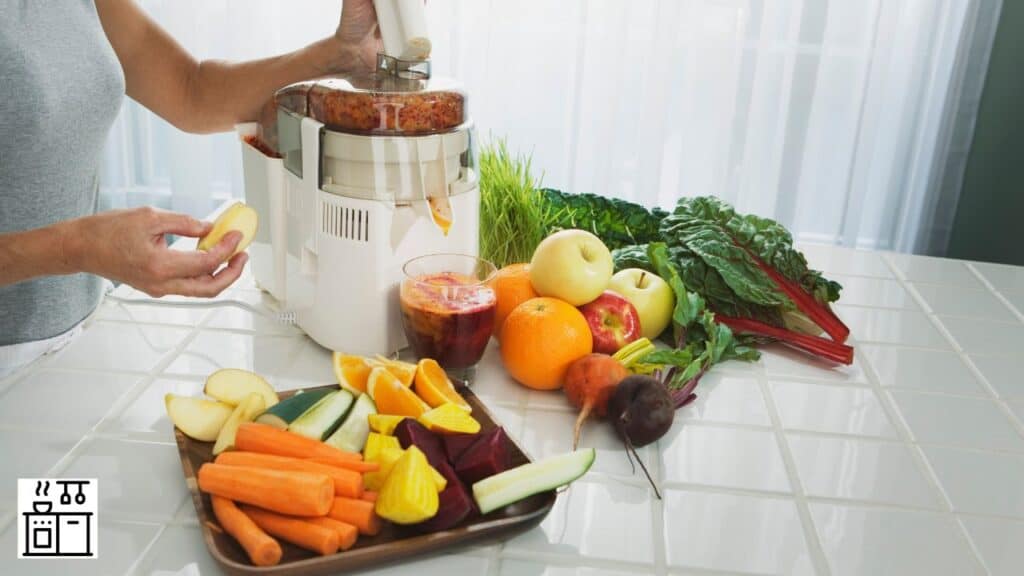Juicers have grown in popularity in recent years with more people adding healthy juices to their daily menu.
There are different types of juicers, but all of them essentially separate the pulp from the liquid.
Let’s take a closer look at the different types of juicers to understand how they work.
Types of Juicers
We can broadly classify juicers into the following types:
- Centrifugal Juicers,
- Masticating Juicers,
- Triturating Juicers,
- Hydraulic Press Juicers,
- Citrus Juicers, and
- Steam Juicers.
How Do Different Types of Juicers Work?
Here is how each type of juicer works.
How Do Centrifugal Juicers Work?
Centrifugal juicers are very popular for household needs because of their efficiency and affordability.
They are called fast juicers because they finish juicing much faster than other types of juicers.
The juicing process begins by feeding the fruits or vegetables into the juicer jar through the feeding tube in the lid.
The ingredients fall toward the blade that spins at a very high speed. The spinning blades chop and crush them, releasing juice.
The juice is hurled in an outward direction by the blades. This is because there is a centrifugal force at play.
This juice is then pushed through a screen or straining system into the collecting utensil.
While centrifugal juicers do a good job of extracting juice quickly and efficiently, the product is not the best.
A part of it will be solid produce since these machines can’t entirely separate the solid part. So, there will be some skin, seeds, fiber, or stem pieces in your juice.
Centrifugal juicers are the best choice if you are on a budget or pressed for time but want to include juices in your regular meal plan.
How Do Masticating Juicers Work?
Masticating juicers are more efficient than centrifugal juicers. They use a gentle crushing process to extract more liquid from the produce.
So you will find that the same fruit yields more juice when you use a masticating juicer.
The operation of a masticating juicer involves crushing the fruit or vegetables at a slow speed.
The benefit of this approach is that the entire fruit or vegetable is compressed till all the liquid flows out.
So the pulp that remains is much drier than that of a centrifugal juicer.
The texture of the juice will also be drastically different. The juice from a masticating juicer doesn’t separate over time because it has negligible to zero solid components.
However, it sucks the entire flavor from the ingredient. So you may find that the juice from vegetables like kale or spinach is very bitter when prepared in a masticating juicer.
Masticating juicers are also called cold press or auger juicers because of how they operate. They are often costlier than centrifugal juicers.
Apart from extracting juice from fruits and vegetables, you can also use these juicers to make nut milk with nuts like almonds, cashews, and coconuts.
The downside of this juicer is that it’s difficult to clean. A masticating juicer has many intricate parts.
This juicer is best for those who are very health-conscious and are serious about the quality of the juice they consume.
How Do Triturating Juicers Work?
Triturating juicers are also called twin-gear juicers. They resemble masticating juicers, but the operating parts are different.
These juicers use two twin stainless steel interlocking gears or augers for their operation. They work in tandem to grind produce fed to the juicer.
The interlocking gears have fine teeth that rotate in opposite directions. This helps to crush and grind the ingredients better.
Another difference is that are much slower in speed than regular masticating juicers. The slower the process, the less chance of oxidation.
Slow juicing also increases the nutritional value of the juice.
Overall, triturating juicers produce more and better yield than centrifugal and masticating juicers. Hence, they are also more expensive.
How Do Hydraulic Press Juicers Work?
Hydraulic press juicers can be used for more operations than extracting juice from vegetables and fruits. These devices are also called Norwalk juicers.
They use a two-step process to extract the juice. In the first step, they grind the produce to a pulp using a sharp rotating blade.
In the next step, the pulp is removed and pressed to release juice. For this, the pulp is taken out and placed in a linen cloth before being returned to the hydraulic press. The press applies extreme pressure to the pulp. This yields maximum juice.
The juice produced by a hydraulic press is high-quality because there is no heat involved. It also undergoes minimum oxidation. So the nutritive quality of the juice is also very high.
Hydraulic juicers are very expensive. They are also more complex and require more manual involvement than the other varieties. Hence, these juicers are not very popular for regular household use.
How Do Citrus Juicers Work?

Citrus fruits are very different from other fruits and vegetables in texture and form. Hence, they need dedicated juicer designs for juice extraction.
If you are fond of consuming juices from fruits like lemons, oranges, grapefruits, and other citrus varieties, this juicer is a good investment.
Citrus juicers typically have a reamer, which is a cone-shaped attachment at the top. To extract the juice, the reamer is spun by the motor at the base.
The reamer will press into the fruit and squish it. The liquid will flow through the strainer into the collecting jar. Meanwhile, the pulp that is simultaneously ejected will be held by the strainer.
You can’t use citrus juicers to extract juice from other types of produce besides citrus fruits. So it’s a dedicated device for citrus fruits only.
However, it may sometimes come as an attachment with advanced food processor or juicer models.
How to Use a Steam Juicer?
Steam juicers are specialty juicing devices. They take longer than other types of juicers for juicing ingredients.
Hence, these devices are better suited for the bulk preparation of juices. They are more of a niche instrument.
Steam juicers have three parts: a water reservoir, a juice kettle, and a steam chamber.
Steam juicers use heat and steam to extract juice from fresh produce. You can use them for both vegetables and fruits, including grapes, berries, peaches, plums, and tomatoes.
To operate a steam juicer, begin by filling water in the reservoir. This is located at the very base of the juicer, and it produces steam when heated.
The juice kettle sits on top of the water reservoir. It has a perforated tray or basket where the ingredients are placed.
Finally, the steam chamber covers the juice kettle to collect and direct the steam toward the produce.
When you heat the juicer, the steam from the base permeates the fruits and vegetables. It softens them, breaking down the cell walls.
This releases the juice, allowing it to flow to the bottom of the kettle. The juice then flows through the spout and collects in a separate container.
The main benefit of a steam juicer is that the process sterilizes the fruits and vegetables, ensuring excellent hygiene.
Additionally, the juice is clearer than the juice you extract using other types of juicers.
The residual pulp from this method can also be used for other recipes, like jams, jellies, or fruit sauces.

